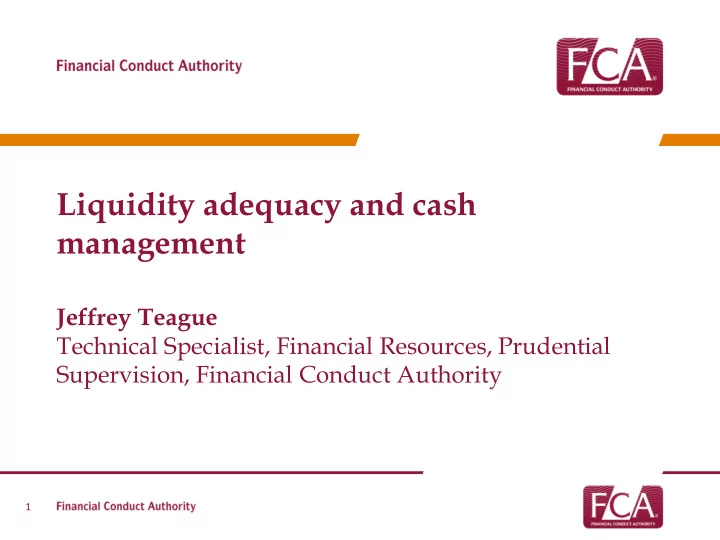

Liquidity adequacy and cash management Jeffrey Teague Technical Specialist, Financial Resources, Prudential Supervision, Financial Conduct Authority 1
Objectives • Provide an update on the liquidity regulatory environment for IFPRU firms • Review liquidity adequacy standards, both quantitative and qualitative • Discuss cash management activities and their impact on liquidity adequacy 2
The liquidity regulatory environment for IFPRU firms 3
CRD IV liquidity requirements CRD IV – CRR Part Six • New quantitative standards (LCR) • Qualitative standards (similar to BIPRU standards) • Liquidity Delegated Act • EBA SREP Guidelines • Liquidity adequacy and risk framework discussions now • required in ICAAP and SREP (Titles 8 and 9) Pillar 2 Liquidity Requirements • Essentially, the systems and controls sections of BIPRU 12 • 4
Liquidity Delegated Act Provides detail for calculating the binding LCR • Applies from 1 October 2015 • New COREP liquidity templates • Does not apply to Investment Firms • CRR Article 508(2) mandates a review on the • application of the LCR to Investment Firms 5
What this means for IFPRU firms We stated in PS13/10 – ‘ we confirm our approach to • continue the UK’s liquidity regime (including ILAS) until binding minimum standards for liquidity coverage requirements are implemented in the CRR in 2015’ We will issue a further statement on our liquidity • approach in due course Until then, BIPRU 12 requirements continue to • apply to all IFPRU firms and some Significant IFPRU / ILAS firms will continue to report CRD IV LCR and NSFR COREP templates 6
Liquidity adequacy 7
Overall liquidity adequacy rule ‘A firm must at all times maintain liquidity resources which are adequate both as to amount and quality, to ensure that there is no significant risk that its liabilities cannot be met as they fall due. ’ BIPRU 12.2.1R 8
Overall liquidity adequacy rule What does ‘ at all times’ mean? At all times including during a period of liquidity stress Liquidity covering only a business as usual assessment is inadequate 9
Overall liquidity adequacy rule What stress should be considered and evaluated? ‘Firms are required to develop their own liquidity risk scenarios ranging from mild to “extreme but plausible” in scope and impact’ BIPRU 12.4.1R 10
Overall liquidity adequacy rule What does adequate mean and who determines this? Adequate means the amount of liquidity necessary to maintain overall liquidity within your liquidity risk tolerance You determine this – through your firm specific stress testing required by BIPRU 12.4.1R 11
Liquidity systems and controls ‘A firm must have in place robust strategies, policies, processes and systems that enable it to identify, measure, manage and monitor liquidity risk over an appropriate set of time horizons, including intra-day, so as to ensure that it maintains adequate levels of liquidity’ BIPRU 12.3.4R 12
Cash management and liquidity adequacy 13
Cash management and liquidity adequacy Certain cash management practices inherently impact a firm’s ability to meet the overall liquidity adequacy rule Among these is cash concentration accounts used to • maximise interest conditions on collected cash balance across a group of related entities By using a ‘zero balance account’ (ZBA) structure to move and • manage cash to a central treasury concentration account , participating subsidiaries may not be able to demonstrate compliance with the liquidity adequacy rule This is because they no longer have their liquidity (cash) • on their own balance sheet 14
Why this is an issue The liquidity adequacy rule requires a firm to ‘own’ • the liquidity / working capital it needs to at all times meet its obligations as they fall due If a subsidiary participates in a cash concentration • programme, it gives all, or most of its cash to a central treasury and that subsidiary will not have adequate liquidity on its balance sheet to meet the liquidity adequacy rule If you don’t or can’t meet the liquidity adequacy rule, • you may be in breach of Threshold Conditions 15
The solution The solution is to modify the liquidity adequacy rule • through an Intra-Group Liquidity Modification ( IGLM ) and create a Defined Liquidity Group (DLG) This allows for liquidity to be shared among the firms • participating in the DLG by modifying the BIPRU 12.2.1R Each individual firm in the DLG has access to the total • amount of liquidity within the DLG So long as the total amount of liquidity in the DLG is • sufficient to meet the total liquidity needs of the entire DLG, each member of the DLG is deemed to have access to adequate liquidity 16
IGLM process Firms apply for an IGLM as set out in BIPRU 12.8.7G – • 12.8.13G The applicant firm(s) will need to demonstrate with • clarity that the proposed DLG has, and will continue to have access to sufficient liquidity at all times – this may require the firms seeking to participate in the DLG to submit individually a Liquidity Metric Monitor (LMM) (or FCA 047/048 if the firms are ILAS firms), and an LMM for the proposed DLG Applicant firms must satisfy the statutory tests under • FSMA 17
Recommend
More recommend